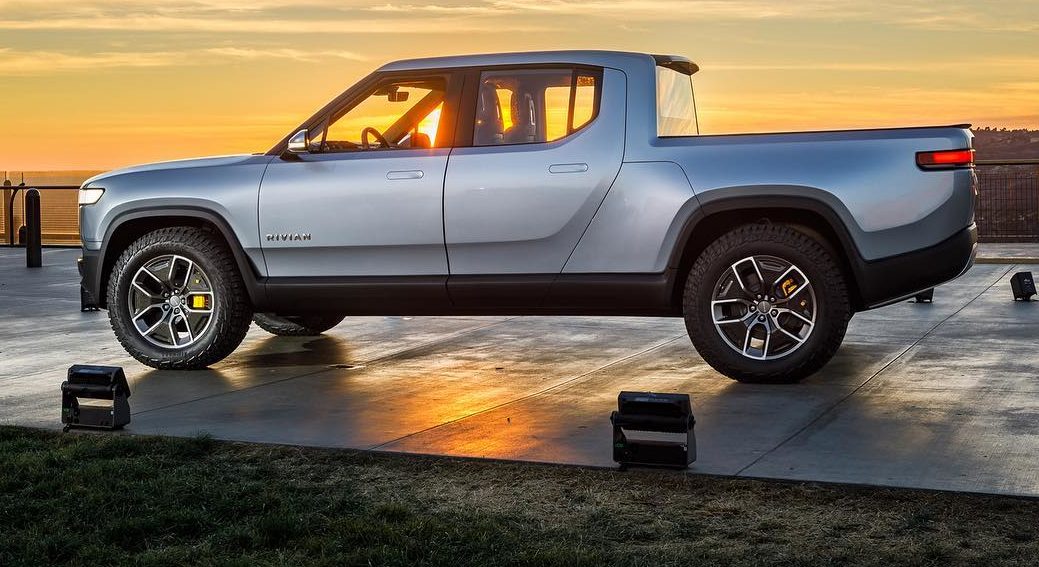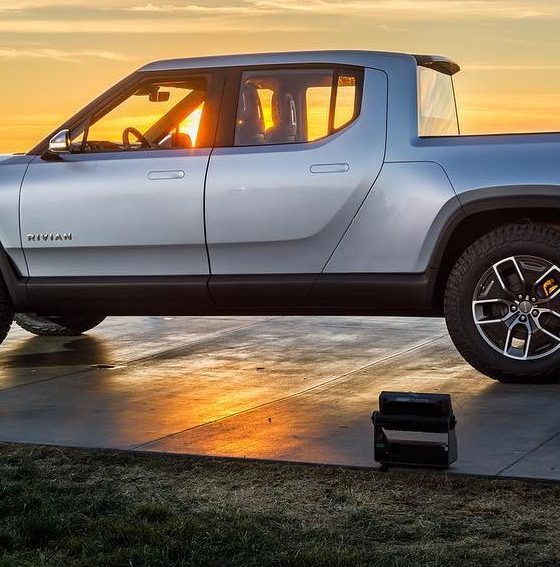

News
Rivian’s patent reveals electric truck’s ability to auto-adjust to removable modules
In a recently issued patent generically titled “Systems and Methods for Reconfigurable Electric Vehicles”, electric truck maker Rivian imagined a customizable driver experience wherein its cars feature both swappable module components and a computer system that adjusts the vehicle’s configurations to fit them. There’s even a potential business opportunity included with the functionality via the suggestion that vehicles and modules don’t need be to owned by the same people.
Planning a jet ski trip but don’t have the right cargo fitting on your SUV? Perhaps you could rent the right bed from a local Rivian module supplier where, after installation, your car will adjust its suspension and height after detecting what’s been installed. There’s a lot of imagination that can be poured into an electric car brand when users are free to customize their vehicles’ utility purpose however they see fit, and Rivian has captured just that in this method patent.
Easily swapping out major parts of a car kind of sounds like something an infomercial might pitch, but according to Rivian, it’s an unfulfilled need in the electric vehicle arena. As summarized by their patent (U.S. Patent No. 10,207,757), there are numerous uses for EVs that aren’t being tapped into because their configurations aren’t adjustable like fossil fuel-powered vehicles. Perhaps the aftermarket availability of numerous non-EV truck bed types, for instance, were part of this invention’s inspiration to create and offer modules for Rivian vehicles.

So, what exactly is a module in the Rivian sense? Perhaps the patent should speak for itself, per claim 28: “…wherein said different removable structural models include a removable recreation module; a removable delivery module; a removable open box utility module; a removable flat bed support module; and a removable side rail module.” The patent further notes that these modules would be attached to Rivian’s vehicles via latching mechanisms. Through these components, Rivian’s electric trucks can accomplish various tasks that would conventionally require multiple vehicle setups.
Rivian’s patent goes beyond just owner convenience and flexibility. In fact, one of the systems claimed is a business structure wherein module-swapping drivers don’t even own the trucks/SUVs but rather use their varied configuration cars on a rental basis. Maybe a delivery service could use the vehicles as needed, outfitted with modules appropriate for the size and shape of their haul. Or a business traveler could rent special configurations based on their particular trips’ needs.

Additionally, proposed data tracking capabilities could provide usage monitoring that would create preferential settings based on a renter’s history with the Rivian pool fleet. Things like braking sensitivity and ride firmness would be part of the customized customer experience using this data.
Although it’s only somewhat recently made its entry into the all-electric car manufacturing scene and won’t have production cars coming off the line until 2020, Rivian is already making waves with its clever innovations. Extra large battery packs with low centers of gravity and high ground clearance are expected to provide an impressive 400 miles of range with 200 horsepower available at each wheel, and smaller auxiliary packs that function like portable fuel tanks are anticipated to be available as well.
Since Rivian’s electric trucks are meant to be luxury adventure vehicles as well as modularized utility units (potentially), self-driving guided tours reminiscent of those in Jurassic Park are also on the feature list. The coming announcements certainly sound exciting, and for those ready to make the leap into ownership, Rivian has opened up reservations for both vehicles on its website, estimated to be in the $60,000 range after incentives.

Elon Musk
Tesla’s Elon Musk: 10 billion miles needed for safe Unsupervised FSD
As per the CEO, roughly 10 billion miles of training data are required due to reality’s “super long tail of complexity.”

Tesla CEO Elon Musk has provided an updated estimate for the training data needed to achieve truly safe unsupervised Full Self-Driving (FSD).
As per the CEO, roughly 10 billion miles of training data are required due to reality’s “super long tail of complexity.”
10 billion miles of training data
Musk comment came as a reply to Apple and Rivian alum Paul Beisel, who posted an analysis on X about the gap between tech demonstrations and real-world products. In his post, Beisel highlighted Tesla’s data-driven lead in autonomy, and he also argued that it would not be easy for rivals to become a legitimate competitor to FSD quickly.
“The notion that someone can ‘catch up’ to this problem primarily through simulation and limited on-road exposure strikes me as deeply naive. This is not a demo problem. It is a scale, data, and iteration problem— and Tesla is already far, far down that road while others are just getting started,” Beisel wrote.
Musk responded to Beisel’s post, stating that “Roughly 10 billion miles of training data is needed to achieve safe unsupervised self-driving. Reality has a super long tail of complexity.” This is quite interesting considering that in his Master Plan Part Deux, Elon Musk estimated that worldwide regulatory approval for autonomous driving would require around 6 billion miles.
FSD’s total training miles
As 2025 came to a close, Tesla community members observed that FSD was already nearing 7 billion miles driven, with over 2.5 billion miles being from inner city roads. The 7-billion-mile mark was passed just a few days later. This suggests that Tesla is likely the company today with the most training data for its autonomous driving program.
The difficulties of achieving autonomy were referenced by Elon Musk recently, when he commented on Nvidia’s Alpamayo program. As per Musk, “they will find that it’s easy to get to 99% and then super hard to solve the long tail of the distribution.” These sentiments were echoed by Tesla VP for AI software Ashok Elluswamy, who also noted on X that “the long tail is sooo long, that most people can’t grasp it.”
News
Tesla earns top honors at MotorTrend’s SDV Innovator Awards
MotorTrend’s SDV Awards were presented during CES 2026 in Las Vegas.

Tesla emerged as one of the most recognized automakers at MotorTrend’s 2026 Software-Defined Vehicle (SDV) Innovator Awards.
As could be seen in a press release from the publication, two key Tesla employees were honored for their work on AI, autonomy, and vehicle software. MotorTrend’s SDV Awards were presented during CES 2026 in Las Vegas.
Tesla leaders and engineers recognized
The fourth annual SDV Innovator Awards celebrate pioneers and experts who are pushing the automotive industry deeper into software-driven development. Among the most notable honorees for this year was Ashok Elluswamy, Tesla’s Vice President of AI Software, who received a Pioneer Award for his role in advancing artificial intelligence and autonomy across the company’s vehicle lineup.
Tesla also secured recognition in the Expert category, with Lawson Fulton, a staff Autopilot machine learning engineer, honored for his contributions to Tesla’s driver-assistance and autonomous systems.
Tesla’s software-first strategy
While automakers like General Motors, Ford, and Rivian also received recognition, Tesla’s multiple awards stood out given the company’s outsized role in popularizing software-defined vehicles over the past decade. From frequent OTA updates to its data-driven approach to autonomy, Tesla has consistently treated vehicles as evolving software platforms rather than static products.
This has made Tesla’s vehicles very unique in their respective sectors, as they are arguably the only cars that objectively get better over time. This is especially true for vehicles that are loaded with the company’s Full Self-Driving system, which are getting progressively more intelligent and autonomous over time. The majority of Tesla’s updates to its vehicles are free as well, which is very much appreciated by customers worldwide.
Elon Musk
Judge clears path for Elon Musk’s OpenAI lawsuit to go before a jury
The decision maintains Musk’s claims that OpenAI’s shift toward a for-profit structure violated early assurances made to him as a co-founder.

A U.S. judge has ruled that Elon Musk’s lawsuit accusing OpenAI of abandoning its founding nonprofit mission can proceed to a jury trial.
The decision maintains Musk’s claims that OpenAI’s shift toward a for-profit structure violated early assurances made to him as a co-founder. These claims are directly opposed by OpenAI.
Judge says disputed facts warrant a trial
At a hearing in Oakland, U.S. District Judge Yvonne Gonzalez Rogers stated that there was “plenty of evidence” suggesting that OpenAI leaders had promised that the organization’s original nonprofit structure would be maintained. She ruled that those disputed facts should be evaluated by a jury at a trial in March rather than decided by the court at this stage, as noted in a Reuters report.
Musk helped co-found OpenAI in 2015 but left the organization in 2018. In his lawsuit, he argued that he contributed roughly $38 million, or about 60% of OpenAI’s early funding, based on assurances that the company would remain a nonprofit dedicated to the public benefit. He is seeking unspecified monetary damages tied to what he describes as “ill-gotten gains.”
OpenAI, however, has repeatedly rejected Musk’s allegations. The company has stated that Musk’s claims were baseless and part of a pattern of harassment.
Rivalries and Microsoft ties
The case unfolds against the backdrop of intensifying competition in generative artificial intelligence. Musk now runs xAI, whose Grok chatbot competes directly with OpenAI’s flagship ChatGPT. OpenAI has argued that Musk is a frustrated commercial rival who is simply attempting to slow down a market leader.
The lawsuit also names Microsoft as a defendant, citing its multibillion-dollar partnerships with OpenAI. Microsoft has urged the court to dismiss the claims against it, arguing there is no evidence it aided or abetted any alleged misconduct. Lawyers for OpenAI have also pushed for the case to be thrown out, claiming that Musk failed to show sufficient factual basis for claims such as fraud and breach of contract.
Judge Gonzalez Rogers, however, declined to end the case at this stage, noting that a jury would also need to consider whether Musk filed the lawsuit within the applicable statute of limitations. Still, the dispute between Elon Musk and OpenAI is now headed for a high-profile jury trial in the coming months.








